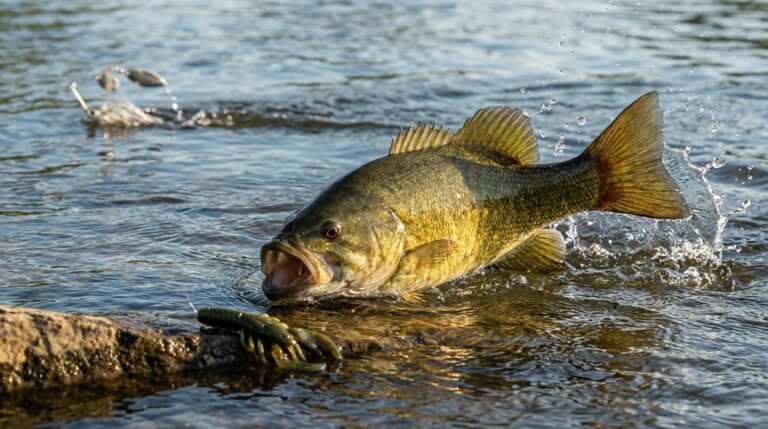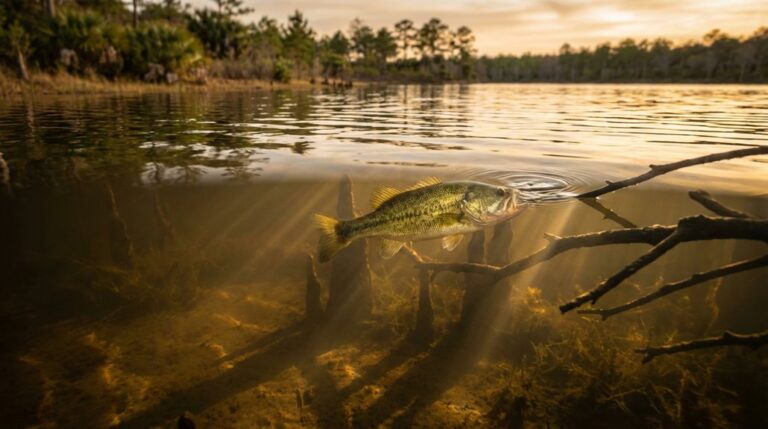You'll find the Guadalupe bass's current population at 2-4 million individuals, primarily in central Texas's Edwards Plateau region. While this Texas state fish faces ongoing threats from hybridization with smallmouth bass and habitat loss, conservation efforts have shown promise. Since 1992, Texas Parks and Wildlife has stocked over 2.3 million pure-strain fingerlings and implemented protective measures. The species' future depends on continued management strategies that balance preservation with recreational fishing opportunities.
Current Population Status and Distribution
While Guadalupe bass remain relatively abundant with an estimated 2 to 4 million individuals, their distribution is limited to central Texas's Edwards Plateau region.
You'll find these endemic fish primarily in the Colorado, Guadalupe, Llano, and San Marcos rivers and their tributaries.
However, Guadalupe Bass populations face significant challenges that concern Texas Parks and Wildlife conservationists. Recent genetic testing has revealed troubling hybridization rates, with over one-third of the population in the Guadalupe River and nearly half in the San Gabriel River showing hybrid characteristics from introduced smallmouth bass.
Despite these challenges, conservation efforts have made progress in establishing refuge populations to protect genetically pure specimens.
These initiatives are vital for maintaining viable populations across the species' native central Texas range.
Historical Decline and Recovery Efforts
Although Guadalupe bass populations remained stable through the mid-20th century, the species faced a severe decline during the 1970s and 1980s due to widespread hybridization with introduced smallmouth bass.
Alarming rates of up to 46% hybridization in some rivers prompted the Texas Parks and Wildlife Department to launch an aggressive conservation plan in 1991.
Key aspects of the recovery effort include:
- Stocking over 2.3 million pure Guadalupe fingerlings since 1992
- Establishing a refuge population in the Sabinal River
- Implementing genetic purity monitoring programs
- Using specialized hatchery techniques with nesting boxes
- Creating targeted restoration initiatives in affected waterways
Habitat Requirements and Management

Because Guadalupe bass have evolved to thrive in specific environmental conditions, their habitat requirements play a crucial role in their survival and conservation.
You'll find these fish in clear, cool flowing waters across Central Texas's Edwards Plateau, where they depend on rocky substrates and native vegetation for their lifecycle.
As juveniles, they prefer fast-moving waters, while adults seek deeper currents.
To protect these environments, you'll need to address habitat degradation through targeted conservation efforts.
Effective management practices include installing fish-friendly bridge designs and controlling invasive plants that threaten native vegetation.
These measures help maintain the diverse water flow conditions and natural cover – like rocks, cypress trees, and stumps – that Guadalupe bass need to survive.
Threats From Hybridization
Since the introduction of smallmouth bass into Central Texas waterways, hybridization has emerged as one of the gravest threats to Guadalupe bass survival.
As a species of concern, you'll find these native fish facing unprecedented challenges to their genetic purity, with some populations showing alarming hybrid rates.
- Hybridization rates reach 34% in the Guadalupe River and 46% in the San Gabriel River
- The Blanco River has lost all pure Guadalupe bass populations
- Nearly half of some river populations are now hybrids
- Genetic dilution threatens unique species traits and ecological roles
- The Texas Parks and Wildlife Department's stocking programs aim to restore pure populations
You're witnessing a critical conservation challenge where preserving pure Guadalupe bass genetics has become vital for the species' future.
Without intervention, continued hybridization could lead to the loss of this unique Texas native.
State and Federal Protection Measures

As Guadalupe bass populations face mounting threats, state and federal agencies have mobilized extensive protection measures. The Texas Parks and Wildlife Department leads conservation actions through their successful hatchery program, which has introduced over 2.3 million pure-strain fish to combat hybridization. You'll find these efforts complemented by habitat restoration projects and stronger regulations against water pollution.
| Protection Measure | Lead Agency | Impact |
|---|---|---|
| Hatchery Program | TPWD | 2.3M fish stocked |
| Habitat Restoration | Local Partners | 7,754 acres restored |
| Water Quality Rules | State/Federal | Pollution reduction |
| Landowner Programs | TPWD | Improved stewardship |
| RAWA Funding | Federal | $60M for Texas |
The Recovering America's Wildlife Act will further boost these initiatives by providing essential funding, ensuring you'll see continued support for Guadalupe bass conservation across their native range.
Breeding Programs and Stock Enhancement
The Texas Parks and Wildlife Department's hatchery program stands at the forefront of Guadalupe bass conservation. Since 1992, you'll find remarkable progress in breeding programs and stock enhancement efforts aimed at preserving this unique species.
Key achievements in Guadalupe Bass conservation include:
- Implementation of specialized nesting boxes to improve hatchery survival rates
- Release of over 2.3 million pure fingerlings into targeted waterways
- Successful reduction of hybridization to 2% in the South Llano River
- Elimination of smallmouth bass stocking in Hill Country waters
- Annual target of 500,000 pure Guadalupe bass through ongoing restoration efforts
These initiatives demonstrate how targeted breeding programs can effectively combat hybridization while boosting native populations.
The success in the South Llano River particularly showcases the potential for similar outcomes in other waterways through continued stock enhancement efforts.
Research and Monitoring Methods

Modern research efforts monitoring Guadalupe bass populations rely heavily on genetic analysis and habitat surveys to track conservation progress.
You'll find scientists conducting extensive genetic testing to measure hybridization rates with smallmouth bass, which have reached concerning levels of 46% in areas like the San Gabriel River.
Research teams at Texas Tech University and local watershed alliances are studying the species' dietary patterns throughout different life stages.
They're also performing detailed habitat assessments to identify vital conservation areas.
Current monitoring indicates there are 2 to 4 million adult Guadalupe bass remaining in the wild.
These thorough studies help researchers develop targeted management strategies to protect pure populations and restore critical habitats.
The collected data guides conservation planning and guarantees the long-term survival of this unique species.
Watershed Conservation Initiatives
Building on research findings, watershed conservation initiatives have emerged as powerful tools for protecting Guadalupe bass populations. The Texas Parks and Wildlife Department's South Llano River Initiative demonstrates remarkable success in reducing hybridization to just 2% while stocking 793,000 pure Guadalupe bass since 2010.
Key elements of successful watershed conservation include:
- Identifying eight priority river stretches with healthy habitats
- Installing fish- and paddler-friendly bridge designs to improve habitat connectivity
- Controlling invasive plants like arundo and elephant ear
- Partnering with landowners to restore over 78,000 acres of ranchland
- Managing upland practices to protect instream habitats
You'll find these initiatives create a thorough approach that addresses both immediate threats and long-term sustainability of Guadalupe bass populations through strategic watershed management and community engagement.
Economic Impact on Recreational Fishing

While conservation efforts protect Guadalupe bass populations, these initiatives also generate substantial economic benefits through recreational fishing. In Texas waters, anglers contributed $71 million over 16 months, with 42% specifically targeting Guadalupe bass. This economic impact strengthens local economies through tourism and related businesses. Additionally, sustainable practices in fishing ensure the longevity of local fish populations, further enhancing recreational fishing opportunities.
| Activity | Economic Benefit | Community Impact |
|---|---|---|
| Guide Services | Direct Income | Job Creation |
| Bait & Tackle | Local Sales | Business Growth |
| Lodging | Tourist Revenue | Tax Generation |
| Food & Dining | Service Income | Economic Stability |
You'll find that successful conservation efforts don't just preserve the species – they're creating sustainable recreational fishing opportunities that benefit entire communities. As Guadalupe bass populations thrive, you can expect continued growth in tourism and related economic activities, ensuring long-term prosperity for regions dependent on recreational fishing.
Future Conservation Strategies
Strong economic returns from recreational fishing have reinforced the need for expanded conservation strategies to protect Guadalupe bass populations.
The Wildlife Department's extensive conservation plan focuses on several key initiatives to secure the species' future.
- Annual stocking of 500,000 pure Guadalupe Bass to boost population numbers
- Implementation of targeted programs to reduce hybrid population rates to 2%
- Expansion of habitat restoration efforts across 78,000 acres of ranchlands
- Allocation of $60 million from RAWA funding to support conservation projects
- Research programs studying diet, growth, and genetic diversity
You'll see these strategies working together to create a sustainable future for the species.
With continued collaboration between landowners, researchers, and conservation organizations, the long-term survival of Guadalupe Bass looks promising through these science-based management approaches.
Frequently Asked Questions
Can You Keep Guadalupe Bass in Texas?
You can keep Guadalupe bass in Texas, but they must be less than 14 inches long. If you catch one that's 14 inches or longer, you'll need to release it back into the water.
What Is the Biggest Guadalupe Bass Ever Caught?
The largest Guadalupe bass you'll find on record is 3.71 pounds, caught by Dr. Bryan Townsend in 2014. That's pretty impressive, considering most Guadalupe bass you'll catch are under 1.5 pounds.
What Is the Lifespan of a Guadalupe Bass?
You'll find that Guadalupe bass typically live around 6 years on average, though they can reach up to 10 years if conditions are favorable. Their lifespan depends on water quality, food availability, and predation pressures.
What Is the Rarest Fish in Texas?
You'll find the Guadalupe bass among Texas' rarest fish, though the Texas blind salamander and fountain darter might be considered rarer. These endangered species face ongoing threats in Texas' delicate aquatic ecosystems.
Final Thoughts
You'll find that the Guadalupe bass's future depends on continued vigilance and collaborative conservation efforts. While you can see progress in population recovery and habitat protection, you'll need to remain focused on preventing hybridization with smallmouth bass and preserving water quality. Your support of watershed initiatives and recreational fishing regulations will help guarantee this Texas native species thrives for generations to come.




